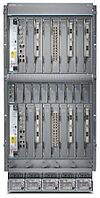Juniper Networks facts for kids
 |
|

Juniper's headquarters in Sunnyvale
|
|
| Public | |
| Traded as | |
| Industry | Networking hardware |
| Founded | February 6, 1996 |
| Founder | Pradeep Sindhu |
| Headquarters |
,
United States
|
|
Key people
|
|
| Revenue | |
|
Operating income
|
|
| Total assets | |
| Total equity | |
|
Number of employees
|
11,144 (2023) |
Juniper Networks, Inc. is an American company based in Sunnyvale, California. This company creates and sells products that help computer networks work. These products include routers, switches, and tools for network security. They also make software to manage networks.
The company started in 1996. It was founded by Pradeep Sindhu. Scott Kriens was the first CEO. Juniper Networks quickly grew. By 2001, it was a major player in the market for special routers. These routers help direct internet traffic. In 2024, another big tech company, Hewlett Packard Enterprise (HPE), agreed to buy Juniper Networks.
Contents
History of Juniper Networks
How Juniper Networks Started
Pradeep Sindhu got the idea for Juniper Networks in 1995. He was a scientist at a research center. He wanted to build special routers. These routers would be great at handling internet traffic. He started the company in February 1996.
Juniper Networks got money from investors early on. In its first year, it raised $12 million. Scott Kriens became the CEO to run the business. Pradeep Sindhu became the Chief Technology Officer. The company also got investments from big phone companies like Siemens and AT&T.
Growing and Going Public
In 1998, Juniper Networks made $3.8 million. By 1999, its main product, the M40 router, was used by 50 phone companies. Juniper also made deals to sell its products around the world. It opened offices in Europe and Asia.
In 1999, Juniper Networks offered its shares to the public for the first time. This is called an initial public offering (IPO). The company's stock value grew very fast. It became worth $4.9 billion on its first day. Within a year, its stock value grew five times bigger.
By 2000, Juniper Networks' sales grew to $673 million. The company also moved its main office to Sunnyvale, California.
Competing in the Market
By 2001, Juniper Networks controlled a big part of the market for high-end routers. These are used by internet providers. Many experts thought Juniper's products were better than those from Cisco. Cisco was a much bigger company. People often saw Juniper as a "David versus Goliath" story.
Cisco tried to compete by releasing new routers. But Juniper's top routers were very fast. Other companies also tried to make faster routers. Both Juniper and Cisco often boasted about how fast their products were. By 2004, Juniper had a 38% share of the core router market.
Further Growth and Changes
In the early 2000s, Juniper Networks started working with companies like Ericsson and Nortel. They developed new products for mobile internet and fiber optics. However, the company's growth slowed down in 2001. This was because of a downturn in the tech industry. Some employees were laid off.
Juniper Networks recovered by 2004. Its sales went over $1 billion for the first time. By 2005, sales reached $2 billion. The company also started making products for businesses. Before, it mostly served internet providers. By 2005, businesses made up one-third of its sales.
In 2008, Scott Kriens became chairman. Kevin Johnson became the new CEO. Johnson focused more on software products. In 2012, some employees were laid off. In 2013, Kevin Johnson announced he would retire. Shaygan Kheradpir became CEO in 2014. Later that year, Rami Rahim took over as CEO.
In 2015, Juniper announced it found some unauthorized code in its ScreenOS products. This code was fixed with updates. In January 2024, Juniper Networks agreed to be bought by Hewlett Packard Enterprise (HPE) for $14 billion. This deal will help HPE with its networking and AI tools.
Acquisitions and Investments
Juniper Networks has bought many smaller companies over the years. This helps them get new technology and products. In 2002, they bought Unisphere Networks. In 2004, they made a big purchase, buying NetScreen Technologies for $4 billion. NetScreen made network security products.
In 2005, Juniper bought five more companies. These included Redline Networks and Peribit Networks. These companies helped Juniper with speeding up applications and managing wide area networks. After 2005, Juniper didn't buy many companies until 2010.
From 2010 to 2011, Juniper bought six companies. They also invested in eight others. They often bought small, new companies. Then they would improve their technology and sell it to Juniper's customers. Some of these purchases included companies that made digital video tools and wireless network software. In 2012, Juniper bought Mykonos Software, which makes security software. They also bought Contrail Systems, which develops software for networks.
More recently, Juniper bought BTI in 2016. This company helps with cloud and metro networks. In 2019, they bought Mist Systems. Mist Systems makes wireless network tools. In 2022, Juniper acquired WiteSand, a company focused on cloud-native security solutions.
Products and Services
Juniper Networks creates and sells many different IT networking products. These include routers, switches, and security tools. They started by selling core routers to internet service providers (ISPs). Now, they also sell products for data centers, wireless networks, and office networks.
Juniper is one of the top companies for routers and switches used by ISPs. They are also a leading company for firewall products. In wireless local area networks (WLAN), Juniper is growing fast. They offer technical support and services through a program called J-Care.
As of early 2020, Juniper's main products include:
|
|
Routers and Switches Explained
Juniper Networks' first product was the Junos router operating system. It came out in 1998. Their first router, the M40, was released that same year. It was a core router for internet providers. It was very fast compared to other products at the time.
Over time, Juniper made more routers. These included the smaller M20 and the M160. They also released the T-series family of routers. These could handle even more data.
By 2003, Juniper had routers for different uses. These included core routers, edge routers, and routers for mobile traffic. Edge routers help direct internet traffic to individual users. Juniper also started making products for cable modems.
In 2008, Juniper released its first switch for businesses, the EX 4200. Switches help connect devices within a local network. Juniper continued to improve its routers and switches. They released the T4000 router in 2010, which was very powerful.
In 2011, Juniper introduced QFabric. This is a special way to transfer data over a network. In 2013, they introduced MetaFabric, another network design. They also released new switches like the QFX5100 family.
Network Security Products
Juniper Networks started offering security tools in 2003. These tools included firewalls and ways to monitor network traffic. A firewall helps protect a network from unwanted access. After buying NetScreen Technologies in 2004, Juniper gained more security products. These included tools for secure meetings and remote access.
Juniper released its first product for small businesses in 2004. It was a remote access device. In 2005, Juniper started offering Network Access Control (NAC) products. NAC helps control who can connect to a network.
In 2008, Juniper released the SRX family of security gateway products. These gateways help protect networks. In 2011, Juniper and AT&T worked together on a mobile security app. In 2012, Juniper added new features to its web security software. This software tries to trick hackers to learn about their methods.
In 2014, Juniper released new security products for virtual machines. They also released tools for "intrusion deception." These tools create fake files and passwords to confuse hackers who get into a network.
In December 2015, Juniper announced they found some "unauthorized code" in their ScreenOS software. This software is used in their NetScreen devices. They quickly released updates to fix these security issues.
Software Defined Networking (SDN)
Juniper Networks has been focusing on software-defined networking (SDN). SDN uses software to manage and control networks. This makes networks more flexible. In 2012, Juniper bought Contrail Systems, an SDN company.
In 2013, Juniper released new SDN products. These included software for setting up applications and a mobile control device. In 2014, they released an SDN controller called NorthStar. NorthStar helps find the best path for data to travel through a network.
Juniper also holds an annual competition called SDN Throwdown. Students from universities around the world use NorthStar Controller to find ways to improve network performance.
Recent Product Updates
In 2015, Juniper announced updates to its PTX routers and QFX switches. They also improved their security products. A report in 2015 showed that Juniper Networks had many patents related to network security.
In 2018, Juniper launched EngNet. This is a set of tools for developers. It helps companies automate their networks. This means networks can manage themselves more easily.
How Juniper Networks Operates
Juniper Networks works in over 100 countries. About half of its sales come from the United States. About 30% come from Europe, the Middle East, and Africa. The rest comes from Asia.
Juniper sells its products directly to businesses. It also works with partners like Ericsson, IBM, and Nokia. About half of Juniper's sales come from routers. Switches make up about 13% of sales. IT security products account for 12%, and services make up 25%.
Juniper Networks invests a lot in research and development (R&D). This means they spend money to create new and better products. R&D expenses have been a big part of their income. Most of the company's products are made by other manufacturing companies.
Juniper also has a program called the Junos Innovation Fund. This fund invests in new tech companies. These companies develop applications for Juniper's Junos operating system.
Images for kids
See also
 In Spanish: Juniper Networks para niños
In Spanish: Juniper Networks para niños
- List of networking hardware vendors









